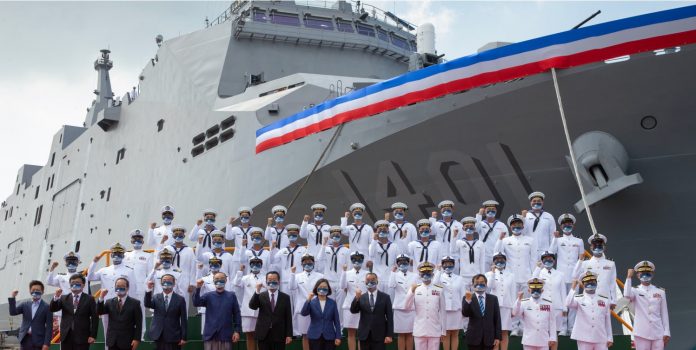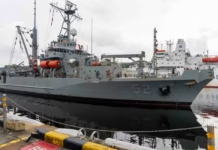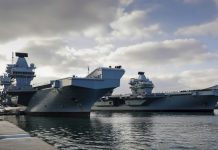
By Sub-Lieutenant Joseph T. Reilly, Royal Navy
If China were to begin a war against Taiwan as soon as 2027 and the United States decides to mount a regional response, the United States would lose.1
It would lose not because of China’s advances in hypersonic missile technology, its advantage in drone numbers, or the loss of U.S. intelligence, surveillance, and reconnaissance capabilities, although these factors would play a significant part in any future conflict. The United States would lose because it anticipates a Taiwan contingency that remains regional, playing out on the maritime “field” China has deliberately chosen.2
Many navalists expect a Sino-American conflict would take place largely in and near the Taiwan Strait, with auxiliary theaters in other areas of the western Pacific, including the South China Sea. In recent wargames, hypothetical battles too often read like a modern iteration of War Plan Orange, the pre–World War II plan in which U.S. fleets drove west across the western Pacific to seek a decisive oceanic clash with the Imperial Japanese Navy.3 Such scenarios range wide in tactical creativity and ingenuity but are strategically misguided.
A U.S. war against China could never remain a regional affair. Julian Corbett was right to caution that in a global war a global map is needed—“a map in which the political features are at least as prominently displayed as the physical.”4 The U.S. Navy needs a global strategy to tackle China, much like the “Rainbow Plans [conceived] just before the beginning of World War II.”5 The potential for war within this decade calls for a modern global war plan that draws from the past and also looks to the future to accurately plan for the conflict ahead.6
To win a war with China over Taiwan, the United States must adopt a three-tier strategy—it must hold, constrain, and advance. Initially, Taiwan must be empowered and supplied to hold off the Chinese attack, with none of the parsimonious hand-wringing that has characterized the response to Russian aggression in Ukraine. It is far easier to defend than to dislodge, and the price not initially paid in Taiwanese munitions will be paid later in American blood.
Next, the Navy must constrain China’s ability to prosecute the war, cutting vulnerable sea lines of communication (SLOCs) with an open blockade across the Indo-Pacific, while recognizing the threat China’s proxies will present to interdiction.
Finally, the United States must accept that blockade and sanctions alone will not suffice, especially when Beijing already will have accounted for those actions. China has spent decades establishing a strategic hinterland that spans Eurasia. For the United States to win the war decisively and avoid stalemate, the scope of its offensive operations must expand to new theaters, with allied regional actors and proxies empowered to target China far from the center of the maritime campaign.
Hold
A successful Chinese invasion of Taiwan would be the “largest and farthest amphibious invasion in modern history”—no mean feat for any nation, let alone one lacking a recent history of amphibious operations.7 Geography alone presents formidable challenges. Taiwan has few deepwater ports, with those on the east coast isolated by steep mountains and narrow, low-capacity roads, and those in the west fiercely defended with mobile, coastal, and hardened missile batteries (the latter embedded deep in the mountains).
Such a landing has been estimated to require more than 300,000 troops. The People’s Liberation Army Navy (PLAN) would be capable of landing only 20,000 at a time—and only if PLA amphibious forces were able to secure a substantial beachhead early in the campaign, successfully capturing several ports intact.8 Most experts conclude that a direct PLAN invasion would be an “extraordinarily high-risk endeavor,” and a blockade would be the most likely approach, alongside a campaign of subversion and sabotage on the island.9 A blockade would take advantage of Taiwan’s disproportionate reliance on trade and would be designed to sap the island of its means and will to fight.10
Since 2008, Taiwan has sought to protect the island using short-range antiship and antiair defenses to hold an invading or blockading force at risk.11 Taiwan also has invested heavily in long-range strike capabilities and now can hit most Chinese coastal provinces and even Beijing.12
The problem with this approach is that the United States continues to arm Taiwan with expensive, high-profile conventional systems that it desperately needs for its own military campaigns, while domestically investing in small, cheap unmanned systems perfectly suited to turn the Taiwanese littoral into a “hellscape.”13 If the United States wishes to hold back China, it must husband its missiles and be generous with its drones. The United States should push Taiwan to adopt an asymmetric defense strategy, enhanced by the Replicator initiative, while preserving and deepening domestic stocks of long-range weapons. Taiwan should use U.S.-provided drones to turn the straits into a boiling moat and use existing stocks of long-range weapons only to safeguard the eastern approaches.14
Constrain
The second U.S. objective must be to make China’s economic prosecution of the war infeasible. The idea that this can be achieved via a “ball-bearing” approach—the targeting of niche, critical, strategic commodities—has been questioned by recent scholarship.15There are no such things as strategic commodities, only strategic needs—such as arming and feeding a population—that can be met through a variety of substitutes. The United States can shut down few, if any, Chinese industries at the outbreak of conflict. While blockade and sanctions cannot accelerate the end of the war, efforts to constrain China’s maritime trade can prevent its unnecessary prolongation.
Some resources would be easier to constrict than others. China imports nearly three-quarters of the oil it uses, and while this constitutes only 20 percent of the country’s energy use, it would be critical to any ongoing war effort. Tanks and ships run on oil, not solar power, and current reserves are predicted to last China’s military only three months at current consumption rates.16 Much effort has gone into rectifying this deficiency. When oil prices crashed during the pandemic, China purchased more than 1 billion barrels for its strategic reserve.17 China’s inventory now hovers near 1.3 billion barrels (as opposed to the United States’ 800 million barrels), enough to cover 115 days of imports, with the potential to reach nearly six months by the end of 2026.18 Nevertheless, an extended war would rapidly diminish these supplies, especially once access to replenishments was cut off.
Oil is unique among China’s resource dependencies. Concerted policy actions for decades have allowed China to amass supplies of metals and energy resources that are among the world’s largest, able “to withstand supply disruptions that could cripple [China’s] economy.”19 In the past year alone, the volume of China’s commodity imports increased 16 percent, despite a struggling economy suffering from stagnant consumption. In the words of one analyst, “China appears to be stockpiling materials at a rapid pace—and at a time when commodities are expensive.”20 China’s underground gas-storage capacity has increased sixfold since 2010, rising to 15 billion cubic meters in 2020, with a target of 55 billion cubic meters this year.21 Indeed, comparing the amount of metals China has been supplied with against the amount it has consumed, new research has determined that China’s current inventory can cover between 35 to 133 percent of annual peacetime demand, depending on the commodity—a staggeringly large reserve.22
Yet, while Beijing’s existing stocks are considerable, they remain finite. Without continual resupply, they will inevitably run low. There are some 50 million Chinese nationals residing in Southeast Asia, with established communities living near all the region’s effective choke points.23 The Chinese government is unlikely to let this asset go unused and allow U.S. forces to conduct with impunity a close blockade in waters such as the Strait of Malacca. Any cutting of Chinese SLOCs would have to take the form of an open blockade, far from antiaccess/area-denial defenses and proxy militias and relying extensively on the capabilities of allies. It would be a long, arduous slog.
Advance
Even with Taiwan held and critical resource SLOCs constrained, the Chinese war effort would not simply wither and die. That is the chimera of blockade. An attempt to take Taiwan by force would never be predicated on three months’ supply of oil. To its west, China sees “abundant resources and a continental vacuum”—prize pickings for a state with surplus capacity and dollar reserves wishing to lessen its dependence on the sea.24
China’s war strategy rests on these “highways, railways, communications and energy channels in the periphery.”25 Belt and Road Initiative megaprojects link Pakistan’s Gwadar Port to westernmost Xinjiang, a direct route that “bypasses strategic chokepoints in the South China Sea and Strait of Malacca,” while a recent decision by Georgia has approved a Chinese-built deepwater port on the Black Sea.26 Such economic routes crisscross Eurasia, providing strategic benefit under notionally commercial investment.
This drive to coopt Eurasia’s vast resources is no more apparent than in China’s relationship with Russia. According to RAND, in a conflict between China and the United States, Russia would “guarantee uninterrupted energy supplies to the Chinese war effort.”27 Pipelines in the Russian Far East contain sufficient capacity to allow Russia to become “China’s largest single supplier of crude oil and liquefied natural gas.”28 As a result of Russia being under international sanctions, it sells gas to China at 28 percent below the market rate.29 Indeed, in the first three years since Russia’s invasion of Ukraine, trade between the two nations increased by more than 60 percent, to some $240.1 billion.30
It should be clear then, that “if the war starts, it’s not just about Taiwan.”31 Most of China’s crucial military targets are located on its mainland.32 Theorists caution that this provides China with greater options to strike U.S. targets abroad and raise the costs of intervention in a Taiwan war, without the escalation implications of a strike on the U.S. homeland.33 Although China has controlling shares in some 93 ports across 53 countries, it has only one confirmed overseas base, in Djibouti and an unconfirmed establishment in Cambodia.34
In a war with China over Taiwan, the United States must be prepared to target Chinese infrastructure across Eurasia. No blockade will bite until these connections are broken, and Taiwan will not have respite until Chinese stockpiles are exhausted. This may, at times, involve dealing with proxy forces hostile to China, funding irredentist movements in China’s outer regions, and fomenting anti-Chinese sentiment in Siberia and Central Asia.
This would not be easy, clean, or quick. Often, the fight would not be maritime in nature. But ultimately, it is the Eurasian network of pipelines and terminals that provide China the redundancy to overcome U.S. efforts at interdiction and would see the Chinese economy through to the war’s conclusion. It is against this network that the United States must advance.
1. Phil Stewart and Idrees Ali, “How the U.S. Is Preparing for a Chinese Invasion of Taiwan,” Reuters, 31 January 2024; and “America and China Are Preparing for a War over Taiwan,” The Economist, 9 March 2023.
2. CAPT Tom Clarity, USN, “Tighten the Belt and Cut the Roads,” U.S. Naval Institute Proceedings 150, no. 1 (January 2024).
3. CAPT Scott Tait, USN (Ret.), and CDR Anthony LaVopa, USN, “It All Comes Down to Sea Control,” U.S. Naval Institute Proceedings 149, no. 12 (December 2023); CAPT William Toti, USN (Ret.), “You Can’t Win Without (More) Submarines,” U.S. Naval Institute Proceedings 149, no. 12 (December 2023); CAPT Scott Smith, USN (Ret.), “Air and Missile Defense in the Western Pacific,” U.S. Naval Institute Proceedings 150, no. 1 (January 2024); and GEN Charles Flynn and LTC Tim Devine, USA, “To Upgun Seapower in the Indo-Pacific, You Need an Army,” U.S. Naval Institute Proceedings 150, no. 2 (February 2024).
4. Julian Corbett, The Seven Years War (London: Folio Society, 2001), 2.
5. CAPT Jeffrey E. Kline, USN (Ret.), “Resurrecting War Plan Blue,” U.S. Naval Institute Proceedings 146, no. 7 (July 2020).
6. Keith T. Ressa, “U.S. vs. The World: America’s Color-Coded War Plans and the Evolution of Rainbow Five,” Liberty University thesis, 2010, 6; and B. J. Armstrong, “Something Borrowed, Something Blue: Integrating Maritime Statecraft and Strategy,” War on the Rocks, 18 July 2024.
7. John Culver, “How We Would Know When China Is Preparing to Invade Taiwan,” Carnegie Endowment for International Peace, 3 October 2022.
8. Lonnie D. Henley, China Maritime Report No. 21: Civilian Shipping and Maritime Militia: The Logistics Backbone of a Taiwan Invasion (Newport, RI: U.S. Naval War College: CMSI China Maritime Reports, 2022), 2; and J. Michael Dahm, China Maritime Report 35: Beyond Chinese Ferry Tales: The Rise of Deck Cargo Ships in China’s Military Activities, 2023 (Newport, RI: U.S Naval War College, 2024), 44.
9. Dahm, Beyond Chinese Ferry Tales, 35, 46; and Bonny Lin, Brian Hart, Matthew P. Funaiole, Samantha Lu, and Truly Tinsley, “How China Could Blockade Taiwan,” Center for Strategic and International Studies, 22 August 2024.
10. Will remains an intangible. Most early commentators of the Russia-Ukraine war were liable to underestimate the morale of Ukrainians. See Eliot A. Cohen and Phillips O’Brien, “The Russia-Ukraine War: A Study in Analytic Failure,” Center for Strategic and International Studies, 24 September 2024, 5.
11. James Timbie and James O. Ellis Jr., “A Large Number of Small Things: A Porcupine Strategy for Taiwan,” Texas National Security Review 5, no. 1 (2021): 83–93.
12. Jens Kaster, “Taiwan Is Turning Itself into a Fortress,” Asia Sentinel, 23 January 2022.
13. CAPT Sam Tangredi, USN (Ret.), “Replicate Ordnance, Not Cheap Drones,” U.S. Naval Institute Proceedings 150, no. 3 (March 2024); and Sam Lagrone and Aaron-Matthew Lariosa, “Pentagon Puts Out Call for Swarming Attack Drones that Could Blunt a Taiwan Invasion,” USNI News, 30 January 2024.
14. “Taiwan Is Trying to Learn from the Wars in Gaza and Ukraine,” The Economist, 5 September 2024.
15. “Why Economic Warfare Nearly Always Misses Its Target,” The Economist, 3 October 2024.
16. “Could Economic Indicators Give an Early Warning of a War Over Taiwan?” The Economist, 27 July 2023.
17. Mark Cozad et al., Future Scenarios for Sino-Russian Military Cooperation: Possibilities, Limitations, and Consequences (Santa Monica, CA: RAND, 2024), 56.
18. “Why Is Xi Jinping Building Secret Commodity Stockpiles?” The Economist, 23 July 2024.
19. “China’s 5-Year Plan to Boost Crude, Metal, Farm Goods Reserves,” Bloomberg, 10 September 2020.
20. “Why Is Xi Jinping Building Secret Commodity Stockpiles?”
21. “Why Is Xi Jinping Building Secret Commodity Stockpiles?”
22. “Why Is Xi Jinping Building Secret Commodity Stockpiles?”
23. Humphrey Hawksley, Asian Waters: The Struggle Over the South China Sea and the Strategy of Chinese Expansion (New York: Abrams Press, 2018), 60.
24. Rush Doshi, The Long Game: China’s Strategy to Displace American Order (Oxford, UK: OUP, 2021), 235.
25. Doshi, The Long Game, 239.
26. Brendon J. Cannon, “Geopolitics in the Himalayas: China’s Strategy, and What ‘Rimland’ States Like India Can Do About It,” Institute for Security and Development Policy, 16 August 2024; and Reid Standish, “Chinese-Led Consortium to Build Massive Port Project on Georgia’s Black Sea Coast,” Radio Free Europe/Radio Liberty, 29 May 2024.
27. Cozad et al., Future Scenarios for Sino-Russian Military Cooperation, 110.
28. Cozad et al., 56.
29. Dan Murtaugh, “Putin in China: Russia’s Pipeline Dream Exposes Beijing’s Energy Advantage,” Bloomberg, 20 May 2024.
30. Alexander Gabuev, “Why China Is Sabotaging Ukraine,” Foreign Affairs, 14 June 2024.
31. CDR Justin Cobb, USN, “No One Should Think the War Will Be Short,” U.S. Naval Institute Proceedings Podcast, episode 416, 19 September 2024.
32. Stacie Pettyjohn and Hannah Dennis, “Avoiding the Brink: Escalation Management in a War to Defend Taiwan,” Center for New American Security, 22 February 2023, 2.
33. Pettyjohn and Dennis, “Avoiding the Brink.”
34. Benedict Hamlyn, “China in Sub-Saharan Africa: Sanction-Proof Supply Lines and Dual-Use Ports,” Royal United Services Institute, 14 March 2024; and Jonathan Head, “Does China Now Have a Permanent Military Base in Cambodia?” BBC, 7 October 2024.



